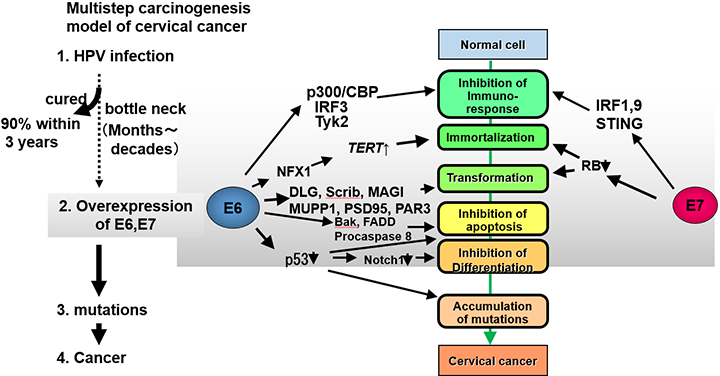Home > Organization > Project for Prevention of HPV-related cancer
Project for Prevention of HPV-related cancer
Almost all the cervical cancers are caused by high-risk HPV (HR-HPV) infection. Other cancers such as also anal cancers, penile cancers, oropharyngeal cancers are also associated with HR-HPV infection. About 5% of all cancers and about 11% of female cancers worldwide are caused by HR-HPV infection. HR-HPVs are sexually transmitted among 80% of sexually active woman in a lifetime. Ninety percent of HPV infections at uterine cervix are immunologically eradicated within 3 years. However, the rest 10% lead to persist infections to generate benign lesions called CIN (Cervical intraepithelial neoplasia). Once a single cell which expresses high levels of viral oncogenes E6 and E7 often caused by accidental integration of HPV genome is generated in the CIN lesion, the cell makes CIN2 and CIN3 also called HSIL (high-grade squamous intraepithelial lesion) and eventually develops into cervical cancer. These cancers would not develop without HPV infection, and HPV-associated cancers are preventable if HPV infection could be prevented. HPV vaccines are wonderful vaccines that can prevent majority of infections with HR-HPVs. Some countries with high coverage rate of HPV vaccination have already shown decrease of HPV-associated precancerous lesions or cervical intraepithelial neoplasms (CINs) epidemiologically. However, in Japan, the coverage rate is less than 2% of target generation, which is exceptional among developed countries, and prevention of HPV infection cannot be expected. In HPV-associated cancers, all the cancer cells contain HPV genome from which viral oncogenes, E6 and E7, are expressed so as to maintain tumor growth and survival. As E6 and E7 can inactivate tumor suppressors, p53 and retinoblastoma protein (pRB), respectively, virtually no mutations in p53 and RB genes can be found and p16INK4A, which activates pRB, is overexpressed. Therefore, if HPV genome could be eliminated from CINs, development of cervical cancer could be prevented, and if the expression of E6 and E7 could be extinguished from HPV-associated cancer cells, these cancers could be cured. Based on the idea, we are developing a new therapy to prevent and treat HPV-associated cancer.


